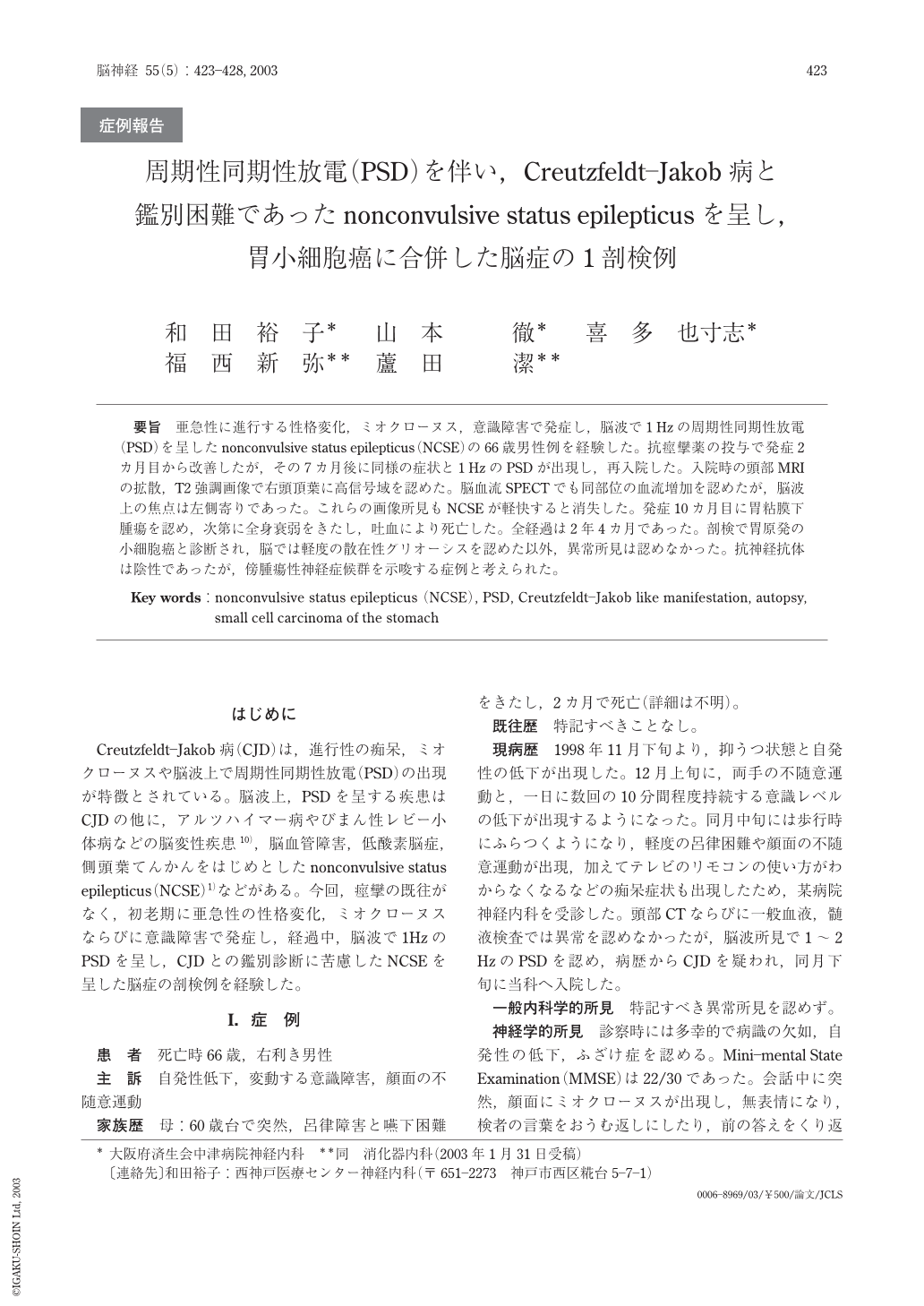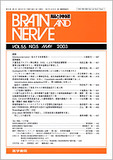Japanese
English
- 有料閲覧
- Abstract 文献概要
- 1ページ目 Look Inside
要旨 亜急性に進行する性格変化,ミオクローヌス,意識障害で発症し,脳波で1 Hzの周期性同期性放電(PSD)を呈したnonconvulsive status epilepticus(NCSE)の66歳男性例を経験した。抗痙攣薬の投与で発症2カ月目から改善したが,その7カ月後に同様の症状と1 HzのPSDが出現し,再入院した。入院時の頭部MRIの拡散,T2強調画像で右頭頂葉に高信号域を認めた。脳血流SPECTでも同部位の血流増加を認めたが,脳波上の焦点は左側寄りであった。これらの画像所見もNCSEが軽快すると消失した。発症10カ月目に胃粘膜下腫瘍を認め,次第に全身衰弱をきたし,吐血により死亡した。全経過は2年4カ月であった。剖検で胃原発の小細胞癌と診断され,脳では軽度の散在性グリオーシスを認めた以外,異常所見は認めなかった。抗神経抗体は陰性であったが,傍腫瘍性神経症候群を示唆する症例と考えられた。
A 64-year-old man developed progressive dementia and altered consciousness with myoclonus over 2 months. Neurological examination revealed mild dysphagia and negative myoclonus of both hands. Electroencephalography (EEG) showed continuous periodic synchronous discharge (PSD) of 1 Hz, although his EEG abnormality was not similar to that usually observed in Creutzfeldt-Jakob disease (CJD). Magnetic resonance imaging (MRI) of the brain revealed only few lacunes. Laboratory data were also normal. Since his consciousness level fluctuated and the PSD were spiky, we came to a diagnosis of nonconvulsive status epilepticus (NCSE). After administering the valproic acid, his symptoms and EEG finding improved.
Nine months after the onset, despite his continued valproic acid, the patient had recurrent NCSE and PSD of 1 Hz. Diffusion-weighted MRI showed a T2-hyperintense lesion in the right parietal lobe, where SPECT scans showed hyperperfusion. After adding zonisamide, he improved slowly. The follow-up MRI and SPECT showed a disappearance of the previous lesion. Now CT scans of the abdomen showed enlarged periaortic lymph node and endoscopic ultrasonography disclosed a submucosal tumor of the stomach. Biopsy of the periaortic lymph node by laparotomy revealed undifferentiated adenocarcinoma with its origin being unclear. Chemotherapy didn’t work well for the tumor and the patient underwent a downhill course, although his mental and neurological manifestation were mostly unremarkable. Two years and four months after the onset, he died in emaciation.
Autopsy confirmed small cell carcinoma originating in the stomach and metastases in the liver and lungs. Neuropathlogical examination revealed only mild scattered gliosis.
This case was unique in the prolonged CJD-like manifestations, which turned out to be due to NCSE. Despite anti-neuronal antibodies were not detected, we suspect yet another paraneoplastic brain syndrome in this patient.

Copyright © 2003, Igaku-Shoin Ltd. All rights reserved.


